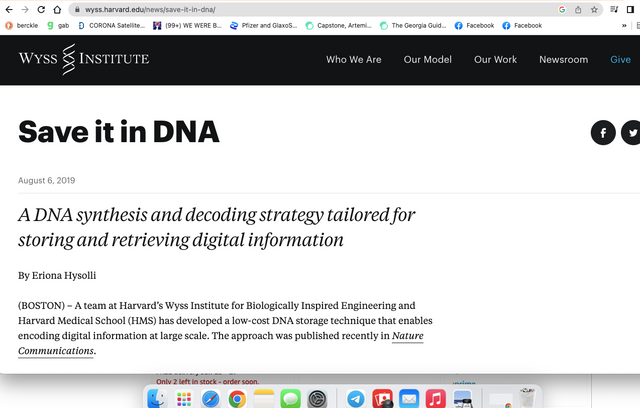RE: Does Light Equal Intelligence? Is Light both a wave and a particle? How Everything in the 3rd Dimension Exists as a Lightwave First. How Consciousness Collapses Electromagnetic Frequencies into Solid Matter!

(BOSTON) – A team at Harvard’s Wyss Institute for Biologically Inspired Engineering and Harvard Medical School (HMS) has developed a low-cost DNA storage technique that enables encoding digital information at large scale. The approach was published recently in Nature Communications.
Information storage has gone through different evolutions from stone to parchment, paper, tape, hard drives, CD/DVDs, and flash drives, to name the main archiving media. While the need for storage technologies has seen dramatic increases over time, these approaches still have drawbacks and limitations such as relatively short longevity and low density of storage. With our drive to generate exponential amounts of data, it becomes increasingly essential to find new ways to overcome these limitations and preserve data safely with guaranteed access for the future.
Save it in DNA
Researchers at the Wyss Institute developed a DNA storage method that utilizes template-independent de novo enzymatic DNA synthesis to generate many short pieces of DNA without the need for a preexisting strand of DNA. Credit: Wyss Institute at Harvard University
George Church, Ph.D., who is a Core Faculty member at the Wyss Institute and Professor of Genetics at Harvard Medical School and of Health Sciences and Technology at Harvard and the Massachusetts Institute of Technology (MIT), first pioneered the idea of using short synthetic DNA as a long-term information storage medium. His team first converted a complete book, including 5.27 megabits of text and images, into a binary digital code, which they then encoded in DNA, and finally decoded again using next-generation sequencing technology. It is estimated that 1 gram of DNA can hold up to ~215 petabytes (1 petabyte = 1 million gigabytes) of information, although this number fluctuates as different research teams break new grounds in testing the upper storage limit of DNA. Assuming the Avengers Endgame movie in 720p HD takes up 6 gigabytes, you can store ~36 million copies of the movie in one gram of DNA. Global digital data is expected to grow to 175 zettabytes (1 zettabyte = 1 million petabytes) by 2025, and because all the digital data in the world can be theoretically stored in ~81kg of DNA, DNA storage is being actively pursued as a compelling storage medium for the future.
What makes DNA so appealing for data storage is: 1) its high density – you can store a lot of data in tiny amounts of mass; 2) stability – dried DNA stored in a cool environment can last thousands of years (oldest DNA sequenced is 700 000 year old); 3) energy-efficiency – it doesn’t take much energy and space to store DNA, just enough to keep it cool; 4) relevancy – biological systems use DNA, and therefore DNA with its possibilities to encode and decode information will not become obsolete like many other data storage media. There are, however, two main drawbacks that at present limit DNA as a universal archiving medium. While both synthesis and sequencing costs are at an all-time low, the costs of synthesizing DNA and then retrieving the data via next-generation sequencing are still much higher than those of using conventional storage media. “In our lab, we continuously develop new methods for biology, medicine, and technology, but the key is to make them multiplexable. DNA storage holds great potential, and our model is faster, cheaper, and at scale,” said Church.